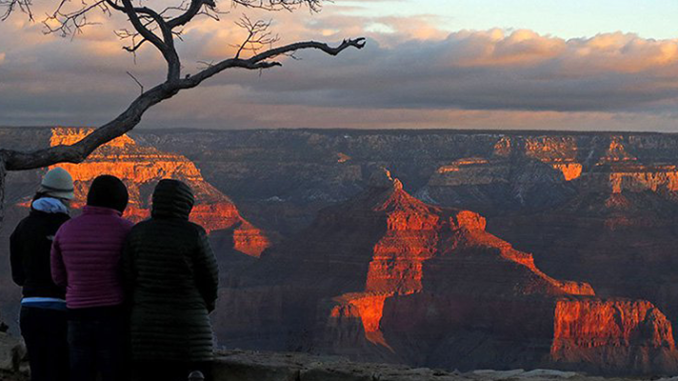
WASHINGTON – Despite a partial government shutdown, Grand Canyon National Park appears to be doing a brisk business – based on the amount of toilet paper workers are taking in to the park and the amount of trash they’re taking out.
Local business officials say park workers have hauled off 106 tons of trash and stocked more than 472,000 feet of toilet paper during a busy three-week period over the holidays. That’s an extra 14 tons of trash and 147,000 feet more toilet paper than in a typical Dec. 22-Jan. 5 period in other years at the park.
“From the waste increase, we feel that there was an increase in park visitation,” said Laura Chastain, general manager of the Grand Canyon Chamber of Commerce, who provided the numbers. She said the park is running at almost 100 percent.
That’s good news for nearby businesses that depend on the park and the millions of visitors it draws every year. Jan Bardwell, information specialist at the Williams visitors center, said business slowed recently with the turn in the weather and the end of holiday attractions, but that it had been steady despite the shutdown.
“We were running 300 or 400 people a day through the visitors center,” Bardwell said. “Usually if we get 60 to 100 a day we are doing pretty good.”
No one will speculate on what might be behind the apparent uptick in visitors but one benefit of visiting Grand Canyon National Park now is that it’s free: Because of the government shutdown, no one is collecting the regular entrance fee.
That also means that there has been no one to count cars. But with the park still open to visitors, officials can measure the amount of trash being generated and toilet paper being used.
And those numbers have been substantial. The 106 tons of trash weighs as much as 15 full-grown African elephants while the 472,000 feet of toilet paper would stretch for just over 89 miles – enough to crisscross the canyon five times at its widest point.
Chastain said the National Park Service has recorded the tonnage of trash collected from Dec. 22 to Jan. 5, one of the park’s busiest times of year, since 2010. The feet of toilet paper used in that same period has been collected since 2016. Averages for previous years were 92 tons of trash and 325,000 feet of TP.
Although the National Park Service is officially shut down, many of the services at the Grand Canyon have continued without a break. Canyon lodges are operated privately by Xanterra Travel Collection, which has not reported a decrease in customers since the shutdown began Dec. 22.
“Visitation has remained stable as have reservations for the train and hotels/lodges,” according to a statement from Xanterra. “The restaurants continue to be busy and business is consistent.”
The park’s visitor center is closed, hikers cannot apply for overnight permits and there are fewer rangers in the park. The gates are open, but no money is being collected.
Arizona had been subsidizing partial park operations at a cost of about $64,000 a week, but that ended this week when the Interior Department said it would tap a maintenance fund to keep the park operating.
“At the direction of the Department of Interior, the National Park Service is using funds from entrance fees to continue current operations at the Grand Canyon,” said Elizabeth Berry, a spokeswoman for Gov. Doug Ducey, in an email. “These operations include maintaining restrooms, trash collection, road maintenance, campground operations, law enforcement and emergency operations and staffing entrance gates.”
Under the Federal Lands Recreation Enhancement Act, 80 percent of entrance fees are kept at the park where they were collected, and that money is being used now, a Park Service spokesman said in an email.
Rangers have returned to the main entrance to hand out maps and assist visitors, but they are still unable to collect entry fees, Chastain said. She said it is likely costing more than the $64,000 a week the state was putting up, but did not have a specific number.
She worries about the long-term impact of using the entry fee fund now, saying it could mean fewer repairs down the road. Chastain also noted that the park would bring in more than $3 million in entry fees in a typical December, with much of that coming at the end of the month.
“We’re looking at $3.3 million of lost revenue,” Chastain said. “You’re making me sad.”
But Bardwell was looking on the bright side. Not only is she able to tell unsure visitors that the park is still open but that, for now at least, it’s free.
“The cat is out of the bag, Williams is a destination now,” she said.
